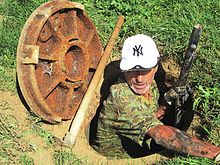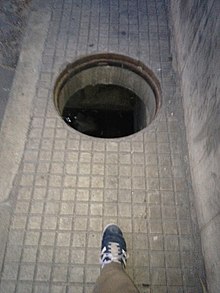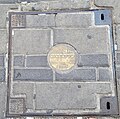Manhole




Amanhole(utility hole,maintenance hole,[1]orsewer hole) is an opening to aconfined spacesuch as ashaft,utility vault,or largevessel.Manholes are often used as an access point for an undergroundpublic utility,allowing inspection, maintenance, and system upgrades. The majority of underground services have manholes, includingwater,sewers,telephone,electricity,storm drains,district heating,andgas.
Manholes are generally found in urban areas,[2]in streets and occasionally undersidewalks.Inruraland undeveloped areas, services such as telephone and electricity are usually carried onutility polesor evenpylonsrather than underground.
In Australia,manholealso commonly refers to anaccess hatchused to get access from a room or hallway into the ceiling cavity of a building.[3][4]These manholes are typically around 450 mm × 450 mm (18 in × 18 in) square.
Construction[edit]

Manhole closings are protected by agratingormanhole cover,a flat plug designed to prevent accidental or unauthorized access to the manhole. These covers are traditionally made of metal,[2]but may be constructed fromprecast concrete,glass reinforced plasticor othercomposite materials(especially where cover theft is of concern). Because of legislation restricting acceptable manual handling weights, Europe has seen a move toward lighter-weight composite manhole cover materials, which also have the benefits of greater slip resistance and electrical insulating properties.
Manholes are usually outfitted with metal,polypropylene,orfiberglasssteps installed in the inner side of the wall to allow easy descent into the utility space.
Manholes are usually round, primarily because roundness is the best shape to resist the compression of the earth; covers are round because they are easier to manufacture than square or rectangular shapes, they are easier to move by rolling, and they can't fall into the opening.[5]But in the United Kingdom they are nearly always square, or rectangular, in shape, at least at street level. Manholes can also be found in a triangular shape (e.g. inCambridge,and surrounding villages).[6]
Composite manholes[edit]
Composite (fiberglass) manholes are commonly used in applications where infiltration, exfiltration, or corrosion byhydrogen sulfide(fromsewer gas) are a concern, or where structures need to be factory integrated into a manhole before placement. In these manholes, the entire underground enclosure is constructed of some composite material, in addition to the cover.
Structures that can be integrated into composite manholes include:
- Flow inverts[7]
- Flumes[8]
- Drop structures from higher elevation flows to lower elevation discharge pipes
- Weirs[9]
- Storm water screening structures[10]
- Sewagegrinders[11]
- Energy absorbing structures to dissipate undesirable flow stream turbulence or velocity[12]
Hazards caused by stray voltage in manholes[edit]
In urban areas,stray voltageissues have become a significant concern for utilities. On January 16, 2004, Jodie S. Lane waselectrocutedafter stepping on a metal manhole cover, while walking her two dogs in New York City.[13]
Sewer manhole location[edit]
The location of a sewer manhole must be carefully considered to ensure that the drainage system is effective and easy tomaintain.[14][15]According to design standards, the distance between two manholes is typically between 7 and 20 meters, depending on the specific characteristics of the project.[16][17]In cities, the distance is 20 meters per manhole,[18]while in industrial or commercial settings it is 10-15 meters per manhole.[19][20]The distance between manholes in homes or restaurants is typically 7-10 meters.[21][22][23]
Gallery[edit]
-
A round manhole in New Orleans, and its cover
-
Manhole cover inBelo Horizonte,Brazil
-
Manhole cover inSawston,Cambridgeshire
-
Manhole cover of precast concrete inGermany
-
Storm drainmanhole without cover inFrance
-
"Man Hole Door" atGirard College,Philadelphia,constructed in the 1840s
-
An openpackaged metering manholemade of fiberglass before installation
-
Manhole cover inKibbutzSasa, Israel
See also[edit]
References[edit]
- ^Nemerow, Nelson L.; Agardy, Franklin J.; Salvato, Joseph A. (2009).Environmental Engineering: Environmental Health and Safety for Municipal Infrastructure, Land Use and Planning, and Industry(6, illustrated ed.). John Wiley & Sons.ISBN978-0470083055.Retrieved2019-07-19.
- ^abSingh, Kanwarjot (2023-06-30)."What is a Manhole- Function, Construction, Materials, and Types of Manhole - Civil Engineering Portal".Civil Engineering Portal - Biggest Civil Engineering Information Sharing Website.Retrieved2024-04-22.
- ^Attribus Innovation (17 January 2019)."Assessment Requirements for CPCCPB3027 Install ceiling insulation products"(PDF).Department of Education and Training(1st ed.). Commonwealth of Australia.Retrieved5 July2019.
- ^"How to install a manhole".Bunnings Warehouse.Retrieved5 July2019.
- ^Scheckel, Larry (December 2013).Ask a Science Teacher: 250 Answers to Questions You've Always Had About How Everyday Stuff Really Works.The Experiment.ISBN9781615190874.
- ^"The ultimate manhole covers site | Info cover | Cover's details: Cambridge - Surface water - Cover in a shape close to the triangle (2)".manhole.co.il.Retrieved13 July2024.
- ^"Manhole inverts"(PDF).Containment Solutions. Archived fromthe original(PDF)on 2015-04-03.Retrieved2013-03-07.
- ^"Packaged Fiberglass (FRP) Flume Manholes".Openchannelflow. Archived fromthe originalon 2013-03-25.
- ^"Packaged Fiberglass (FRP) Weir Manholes for Flow Monitoring".Openchannelflow. Archived fromthe originalon 2013-09-19.
- ^"Fiberglass (FRP) Storm Water Manholes for Initial Oil, Grease, Sediment, and Debris Collection".Openchannelflow. Archived fromthe originalon 2013-03-07.
- ^"Fiberglass (FRP) Grinder Manholes integrating grinders from JWC, Franklin Miller, MonoFlo, and more".Openchannelflow. Archived fromthe originalon 2013-08-28.
- ^"Fiberglass Energy Absorbing Manholes for Controlling Excess Line Velocities".Openchannelflow. Archived fromthe originalon 2013-03-07.
- ^Ramirez, Anthony (January 19, 2004)."East Village Woman Was Electrocuted on Street With Metal Plate, Medical Examiner Says".New York Times.Retrieved2009-12-03.
- ^"Tái diễn tình trạng hố ga mất nắp giữa lòng đô thị thông minh Thái Nguyên".laodong.vn(in Vietnamese). 2023-06-13.Retrieved2023-12-20.
- ^"Cận cảnh vị trí các" lô cốt "sắp lắp đặt trên đường Nguyễn Trãi".suckhoedoisong.vn(in Vietnamese). 2023-05-30.Retrieved2023-12-20.
- ^danviet.vn."Ám ảnh với hố ga mất nắp," nuốt trọn "xe máy của người đi đường".danviet.vn(in Vietnamese).Retrieved2023-12-20.
- ^"Đường mới mở và" điệp khúc "mất nắp hố ga".vovgiaothong.vn(in Vietnamese).Retrieved2023-12-20.
- ^Báo cáo chuyên đề: Mức độ bao phủ của các chương trình y tế công cộng(in Vietnamese). Nhà xuất bản Y học. 2003.
- ^Lê, Thành Châu (2002).Tìm hiểu quy định về quy hoạch, xây dựng, & cấp giá̂y chứng nhận quyền sở hữu nhà ở: áp dụng tại thành phố Hồ Chí Minh và các tỉnh, thành phố trực thuộc Trung ương(in Vietnamese). Thống kê.
- ^Tuyển tập các tác phẩm báo chí Việt Nam thời kỳ đổi mới, 1985-2004(in Vietnamese). Hội nhà báo Việt Nam. 2005.
- ^"Cách sử dụng hố ga ngăn mùi hiệu quả".2013-10-31.Retrieved2023-12-20.
- ^Minh, Huy."Nắp hố ga".thanhanco.vn.Retrieved2023-12-20.
- ^Phan, Thanh Khôi; Lương, Xuân Hié̂n (2006).Một só̂ vá̂n đè̂ kinh té̂ - xã hội trong tié̂n trình công nghiệp hóa, hiện đại hóa vùng đò̂ng bà̆ng sông Hò̂ng(in Vietnamese). Nhà xuá̂t bản Lý luận chính trị.
- Isles, Paul (2010). "Dover Engineering Works".Dover Life Magazine
Further reading[edit]
- Ascher, Kate; Marech, Wendy (2007).The works: anatomy of a city.New York: Penguin Press.ISBN978-0-14-311270-9.











